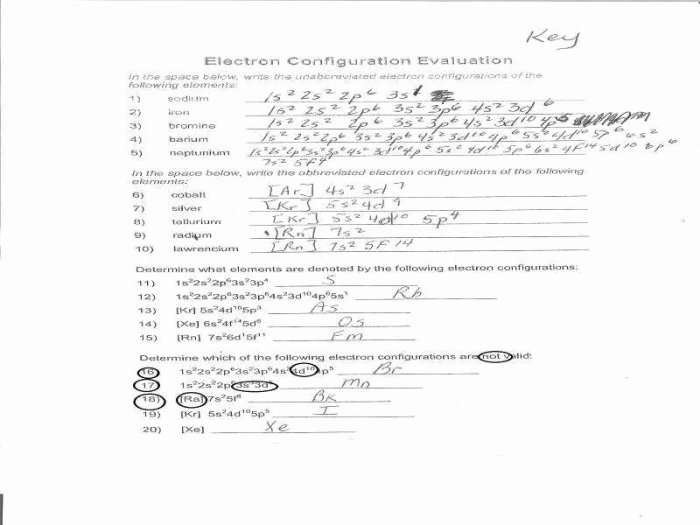Embark on an enlightening journey with our Electron Configuration Worksheet Answer Key, meticulously crafted to provide a comprehensive understanding of this fundamental concept. Delve into the intricacies of electron configurations, unraveling the secrets of atomic structure and unlocking the key to predicting chemical properties.
Through a seamless blend of theoretical explanations and practical examples, this guide empowers you to navigate the complexities of electron configurations with confidence. Prepare to witness the captivating dance of electrons as they occupy their designated orbitals, shaping the very essence of matter.
Electron Configuration of Elements

Electron configuration refers to the arrangement of electrons in different energy levels and orbitals around an atomic nucleus. Understanding electron configuration is crucial in predicting the chemical behavior and properties of elements.
The periodic table organizes elements based on their atomic number, which corresponds to the number of protons and electrons in the atom. Each element has a unique electron configuration, which determines its chemical properties.
Aufbau Principle and Hund’s Rule
The Aufbau principle states that electrons fill the lowest energy orbitals first, starting with the 1s orbital. Hund’s rule states that electrons in degenerate orbitals (orbitals with the same energy) will occupy separate orbitals with parallel spins before pairing up.
Orbital Notation
Orbital notation uses a shorthand notation to represent the electron configuration of an element. Each orbital is denoted by a letter (s, p, d, f) indicating its shape, followed by a superscript number indicating the number of electrons in that orbital.
For example, the electron configuration of helium (He) can be represented as 1s 2, indicating that both electrons are in the 1s orbital.
Valence Electrons
Valence electrons are the electrons in the outermost energy level of an atom. They determine the chemical reactivity of the element, as they participate in chemical bonding.
For example, elements with a full valence shell (e.g., noble gases) are chemically inert, while elements with incomplete valence shells (e.g., alkali metals) are highly reactive.
Electron Configuration of Ions
When an atom gains or loses electrons, it becomes an ion. The electron configuration of an ion can be determined by adjusting the electron configuration of the neutral atom.
For example, when sodium (Na) loses an electron to form a sodium ion (Na +), the electron configuration changes from 1s 22s 22p 63s 1to 1s 22s 22p 6.
Applications of Electron Configuration, Electron configuration worksheet answer key
Electron configuration can be used to predict the chemical properties of elements. For instance, elements with similar electron configurations tend to have similar chemical properties.
Additionally, electron configuration is used in understanding chemical bonding, as it determines the number and type of orbitals available for bonding.
Popular Questions: Electron Configuration Worksheet Answer Key
What is the significance of electron configuration?
Electron configuration plays a crucial role in determining the chemical properties of elements, as it influences their reactivity, bonding behavior, and physical characteristics.
How can I use the Aufbau principle to determine electron configuration?
The Aufbau principle dictates that electrons fill orbitals in order of increasing energy levels, starting with the lowest energy level first.
What is Hund’s rule, and how does it affect electron configuration?
Hund’s rule states that electrons in degenerate orbitals (orbitals with the same energy) will occupy individual orbitals with parallel spins before pairing up.

